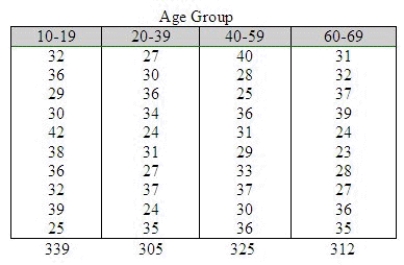Short Answer
An experiment was conducted to examine the effect of age on heart rate when a person is subjected to a specific amount of exercise. Ten men randomly selected from each of four age groups: 10-19, 20-39, 40-59, and 60-69. Each man walked a treadmill at a fixed grade for a period of 12 minutes, and the increase in heart rate (the difference before and after exercise) was recorded (in beats per minute). The data are shown in the table.  Do the data present sufficient evidence to indicate differences in location for at least two of the four age groups? Test using the Kruskal-Wallis H test with
Do the data present sufficient evidence to indicate differences in location for at least two of the four age groups? Test using the Kruskal-Wallis H test with  = 0.01.
= 0.01.
What is H?
______________
What is the critical value for the test statistic?
Reject  if H > ______________
if H > ______________
Conclude: ______________
There is ______________ of a difference in location.
Find the approximate p-value for the test above.
______________
Correct Answer:

Verified
2.39; 11.3449; Fail ...View Answer
Unlock this answer now
Get Access to more Verified Answers free of charge
Correct Answer:
Verified
View Answer
Unlock this answer now
Get Access to more Verified Answers free of charge
Q33: A parametric test is a hypothesis test
Q59: The Spearman rank-correlation is a nonparametric test
Q60: Another school district also planned to evaluate
Q61: Which of the following statements is false?<br>A)
Q62: Which of the following will never be
Q63: If Friedman test is applied to a
Q66: The Kruskal-Wallis H test is an extension
Q67: Kruskal-Wallis test is a nonparametric test that
Q68: The Wilcoxon signed-rank test is a nonparametric
Q69: The critical value is taken from the